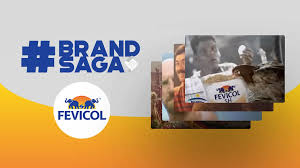Introduction to Fevicol
Fevicol, a flagship brand of Pidilite Industries, is not just India’s most trusted adhesive but also one of its most iconic and beloved brands. Launched in 1959, Fevicol began as a synthetic white resin adhesive for carpenters, offering a revolutionary alternative to traditional animal-based glues. Over the decades, it has evolved from a niche industrial product to a household name—synonymous with strength, trust, and unmatched adhesion.

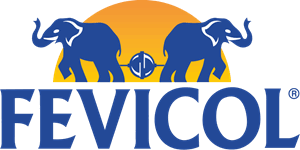
What truly sets it apart is its ability to transcend categories. It has become a part of Indian pop culture, not merely because of its utility but also due to its unforgettable advertising and deep emotional resonance with consumers. Whether it’s furniture makers, DIY hobbyists, or even schoolchildren working on projects, the brand is the go-to adhesive across demographics. The brand portfolio has also expanded to include variants like Fevicol SH, Fevicol Marine, Fevicol Speedx, and Fevicol Hi-Per, catering to specific requirements.
Its marketing strategy has played a pivotal role in its success. The brand’s advertising—largely developed under the creative leadership of Piyush Pandey and Ogilvy India—has delivered some of the most memorable and humorous campaigns in Indian advertising history. Iconic taglines like “Fevicol ka jod hai, tootega nahi” have become part of everyday language. Its ads, often laced with rural charm, wit, and exaggerated metaphors, have resonated widely with audiences while highlighting product strength in the most entertaining way possible.
From TV commercials and print ads to viral digital content and guerrilla marketing, its campaigns are a case study in consistent brand storytelling. Campaigns like the “Egg Tray Bus”, “Fevicol Sofa”, and “Unbreakable Bond“ have earned awards globally and set benchmarks for creativity.
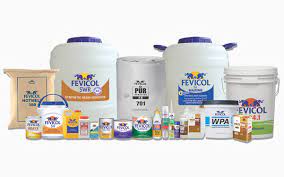
Despite being in a utilitarian category, it enjoys high emotional brand equity. It’s not just seen as a product, but as a symbol of strong relationships and enduring bonds. The brand has tapped into social, emotional, and even humorous contexts to make an otherwise low-involvement product genuinely engaging and memorable.
The brand has also demonstrated adaptability. As consumer behavior evolved, it extended its presence to digital platforms and social media, creating shareable content that retained its signature humor and message. The brand cleverly leverages topical events, festivals, and cultural moments with witty posts and mini-campaigns, ensuring it stays relevant with younger audiences.
Beyond advertising, it engages with carpenters and contractors—its primary users—through community-building programs like “Fevicol Champions Club” and training initiatives. This not only nurtures brand loyalty but also supports the professional growth of its core audience.
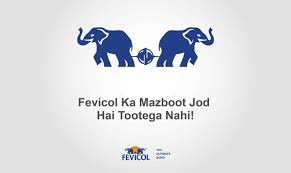
In conclusion, the brand is far more than an adhesive brand. It is a shining example of how strong product performance, paired with emotionally intelligent and culturally rooted marketing, can make a utilitarian product a national icon. With over six decades of innovation, creativity, and consumer trust, the brand remains “the ultimate bond” in Indian homes, workshops, and hearts.
Fevicol’s Marketing Campaigns
Fevicol’s marketing campaigns are a legendary showcase of wit, creativity, and strategic brand-building that transformed a functional adhesive into one of India’s most loved and recognizable brands. Over the decades, Fevicol—manufactured by Pidilite Industries—has consistently delivered advertising that resonates with audiences across rural and urban India, making “Fevicol ka jod” more than just a slogan; it’s a cultural phrase.
This iconic line—meaning ” Fevicol ka jod hai, tootega nahi“—has become embedded in everyday conversations, often used in contexts far beyond glue. It represents emotional, social, or political bonds, further cementing its relevance in the Indian psyche.
Certainly! Here are some of the best and most iconic Fevicol marketing campaigns that have not only captured attention but have also become part of Indian advertising folklore. These campaigns showcase how a functional product like adhesive can be transformed into a memorable, emotionally resonant, and widely loved brand through creative storytelling and humor.
1. Fevicol Bus / Egg Tray Ad (1991)
The Fevicol Bus Ad, popularly known as the “Egg Tray” commercial, aired in 1991 and is widely regarded as one of the most iconic Indian advertisements ever created. Conceptualized by Ogilvy & Mather, this ad showcased its core proposition—unbreakable bonding—with a simple, humorous, and highly relatable narrative set in rural India.
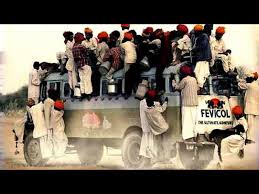
The ad opens with a rickety village bus overloaded with passengers. People are hanging from the sides, sitting on the roof, and even clutching onto every possible edge. Yet, despite the excessive load and the strained condition of the vehicle, the bus miraculously holds together as it moves along bumpy village roads. The secret? The entire bus is held together using Fevicol, applied like glue between panels, windows, and joints—visually represented by an egg tray stuck to the wall with Fevicol that refuses to fall, despite many attempts.
The brilliance of the campaign lies in its visual metaphor. The egg tray—something fragile—remains stuck, just as the overloaded bus refuses to fall apart. This humorous exaggeration left a lasting impression and made the tagline “Fevicol ka jod hai, tootega nahi” a permanent part of the Indian lexicon.
The ad broke new ground for adhesive branding. It showed that marketing for a technical product could be emotional, funny, and culturally relevant. More than three decades later, the Bus ad is still remembered and referenced, marking the beginning of the brand’s legendary journey in Indian advertising.
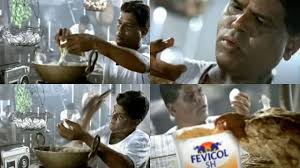
In essence, the 1991 Bus ad not only glued a product to public memory but also set a benchmark for creative storytelling in Indian marketing history.
2. Fevicol Sofa Ad ft. Aamir Khan (2001)
The Fevicol Sofa Ad featuring Aamir Khan in 2001 is one of the most memorable and humorous advertisements in Indian marketing history. Conceptualized by Ogilvy & Mather, this TVC further cemented its positioning as the brand that promises unbreakable bonds—all with a dash of witty, visual storytelling.
Set in a second-hand furniture shop, the ad opens with Aamir Khan playing a quirky, street-smart shopkeeper. As he tries to sell an old sofa to a skeptical couple, the camera subtly shifts to the customers struggling to get up from the sofa after trying it out. Despite their best efforts, they remain stuck—literally! The sofa has been glued with Fevicol, and nothing—not even pushing, pulling, or rocking—can break the bond. Eventually, they give up and agree to buy it, with Aamir flashing a victorious grin.
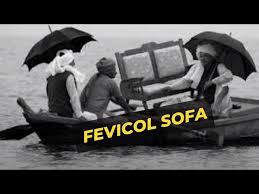
The ad’s brilliance lies in its clever metaphor and unspoken punchline. Rather than showing a carpentry context or technical usage, it humorously exaggerates the adhesive’s strength in a completely unexpected situation. The contrast between Aamir’s casual charm and the absurdity of the couple’s struggle adds to the entertainment value.
This campaign reinforced the legendary tagline, “Fevicol ka jod hai, tootega nahi”, by visualizing it in a fresh and modern retail setting. It marked the brand shift from primarily rural-themed ads to urban-centric storytelling, expanding its appeal among city dwellers and younger audiences.
The Sofa Ad not only won several awards but also became a pop culture reference, remembered for its humor, relatability, and strong brand recall. It exemplifies how a mundane product can be turned into a household name through smart, culturally resonant advertising.
3. Fevicol 50th Anniversary Ad (2009)
In 2009, Fevicol celebrated its golden jubilee with a heartwarming and brilliantly executed TV commercial marking 50 years of “Fevicol ka jod.” The campaign was created by Ogilvy & Mather and served as a tribute to the brand’s unmatched legacy in the Indian adhesive market. Unlike its usually humorous tone, this ad took a more emotional and nostalgic route, making it stand out in the brand’s portfolio.
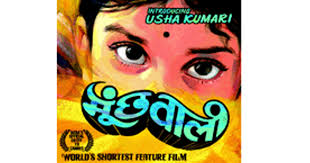
The film follows the journey of a wooden bench across several decades—from the 1950s to the present day. The bench, fixed using Fevicol, passes through generations, serving as a witness to family stories, social changes, and cultural shifts. It begins with the bench being crafted and used in a small home, then being passed on through marriage, children, and various household transitions. As time goes on, the surroundings and people change, but the bench—held together by Fevicol—remains constant, sturdy, and unbroken.
This poignant storytelling becomes a metaphor for the brand itself—a brand that has been an enduring part of Indian homes for decades. The visuals, supported by subtle background music and everyday realism, evoke a deep sense of nostalgia and belonging.
The brilliance of the campaign lies in how it moves beyond product benefits to reflect emotional continuity and heritage. It celebrates the brand not just as a glue, but as a symbol of relationships, memories, and Indian resilience.
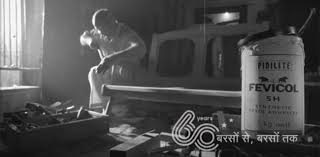
The 50th-anniversary ad was widely appreciated and won numerous accolades. It not only honored the brand’s journey but also deepened its emotional connection with consumers, proving that even a utilitarian product can become a timeless symbol of trust and togetherness when marketed with heart.
4. Fevicol Dahi Handi (2012) – Outdoor Stunt
In 2012, Fevicol pulled off one of its most memorable on-ground marketing stunts during the vibrant Dahi Handi festival in Mumbai, creating a real-world visual metaphor for its famous tagline, “Fevicol ka jod hai, tootega nahi.” The brand, known for its quirky and sticky sense of humor, took its messaging quite literally—by refusing to let the handi break.
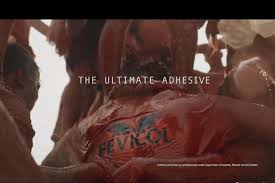
As part of this stunt, the brand set up a specially designed Dahi Handi installation at a busy junction. The earthen pot (handi), traditionally filled with curd and suspended high up, is meant to be broken by human pyramids formed by Govindas. However, in this version, the handi was cleverly fixed with Fevicol. Despite numerous attempts by the enthusiastic crowd to shatter it, the pot stayed intact—unbreakable, much to everyone’s amusement.
What made this campaign brilliant was its contextual relevance and clever use of culture. The Dahi Handi festival is known for its energy, crowds, and excitement, and the brand tapped into this festive spirit with perfect timing and creativity. Onlookers were puzzled and then delighted when the reason behind the unbreakable handi was revealed—it was stuck with Fevicol.
The stunt became an instant hit on social media and news platforms, with people sharing videos and photos of the “indestructible handi.” It showcased its legendary bonding strength in a live, tangible, and humorous way, effectively turning a festival into a brand experience.
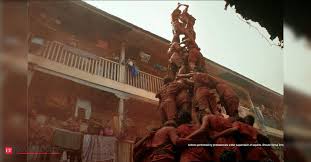
This outdoor stunt not only reinforced its brand promise but also demonstrated how experiential marketing, when done right, can leave a lasting impression on consumers. It was yet another example of how the brand makes advertising that truly sticks—with creativity, culture, and clever execution.
5. Fevicol Marine – Boat Ad
The Fevicol Marine Boat Ad is a standout campaign that creatively highlights the water-resistant strength of Fevicol Marine, a specialized adhesive designed for carpentry in damp and coastal conditions. Departing from the humorous tone often associated with Fevicol, this ad takes on a more realistic and functional approach, showcasing the product’s durability in tough, moisture-heavy environments.
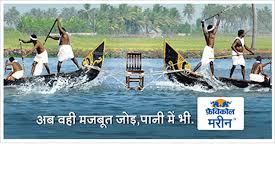
The ad is set in a rural or coastal village, where wooden boats are essential for daily fishing activities. A group of local carpenters is seen building a boat using Fevicol Marine instead of traditional nails or low-grade adhesives. The story follows the newly built boat being tested in choppy waters. While others are skeptical, the fishermen confidently row out to sea, trusting in the power of the glue bond.
As the boat weathers the rough tides and comes back safely, the villagers are impressed. The message is subtle but strong: Fevicol Marine doesn’t just stick — it protects, endures, and performs even in the harshest conditions. The visual of the boat battling through the waves becomes a symbolic metaphor for Fevicol Marine’s resistance against water damage and corrosion.
The tagline reinforces the product’s unique value proposition: “Fevicol Marine – Mazboot jod, paani se na toote.” (A strong bond that even water can’t break.) This campaign effectively targets carpenters, boatmakers, and coastal consumers, reassuring them of long-lasting quality, even in wet conditions.
What sets this ad apart is its product-centric yet emotionally grounded storytelling. It stays true to its brand identity while positioning Fevicol Marine as a trusted solution for professional-grade, water-resistant bonding. With its simple narrative and relatable setting, the ad delivers both functionality and brand loyalty compellingly and memorably.
6. Fevicol Social Media Topicals
Fevicol’s social media topicals are a brilliant example of how a brand can stay relevant, humorous, and culturally connected without losing sight of its core message. Known for its legendary tagline “Fevicol ka jod hai, tootega nahi,” the brand has mastered the art of moment marketing by cleverly integrating trending topics with its brand personality across platforms such as Instagram, Twitter, and Facebook.
Whether it’s a political shake-up, a celebrity wedding, a viral meme, or a major sports event, the brand’s social media team is always ready with a timely, tongue-in-cheek visual or one-liner that instantly connects with the audience. For instance, when news of Rafael Nadal’s resilience went viral, Fevicol posted an image of a tennis racket with the caption: “Fevicol ka jod ho toh aisa”. Similarly, during the Virat Kohli–Anushka Sharma wedding, Fevicol shared a witty post showing a bride and groom stuck together with the iconic Fevicol glue, captioned cleverly to reflect both love and permanence.
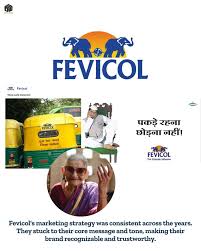
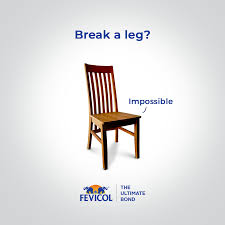
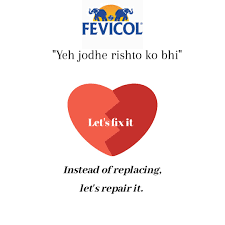
What makes these topicals effective is their minimalist visual design, relatable humor, and brand consistency. Unlike ads that push products directly, these posts engage users subtly, making the brand part of the larger social conversation—whether it’s April Fools’ Day, Valentine’s Day, or World Cup fever.
Moreover, its tone of voice across social media remains unmistakably its own: quirky, desi, and clever. The brand rarely misses a beat when it comes to making the mundane memorable, all while reinforcing the strength of its “unbreakable bond.”
In a digital age where attention spans are short and relevance is everything, its topicals prove that with creativity and cultural awareness, even a glue brand can become a social media rockstar.
7. Fevicol “Jod” Billboard Campaigns
Fevicol’s “Jod” billboard campaigns are legendary in Indian advertising for their sheer creativity, wit, and powerful visual storytelling. Staying true to its iconic tagline — “Fevicol ka jod hai, tootega nahi” — these outdoor advertisements bring the idea of a strong, unbreakable bond to life in larger-than-life ways, often leaving passersby amused, surprised, and deeply impressed.
What makes these billboards so unique is their interactive and three-dimensional execution. One of the most memorable examples is a hoarding where two people are shown stuck to opposite ends of a bench, unable to move — perfectly capturing the adhesive’s strength without a single word. Another striking execution showed a giant egg tray hanging off a billboard, filled with unbroken eggs — a visual callback to an iconic TV ad, reinforcing the idea that even the most fragile things won’t come apart when Fevicol is involved.
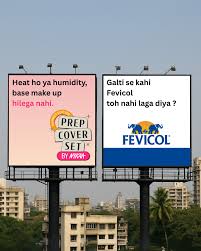
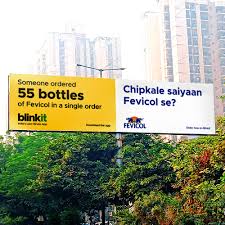
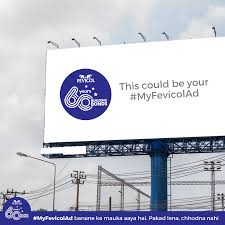
In another brilliant stunt, the brand placed a truck-themed billboard with the appearance of dozens of people clinging to it — just like the overloaded bus from its earlier commercial. The illusion made it look like the billboard itself was weighed down but still firmly stuck, thanks to Fevicol.
These outdoor ads are often minimal on text and heavy on visual metaphors, making them universally understandable and instantly engaging. They’re not just billboards—they’re street-level spectacles that seamlessly blend brand messaging with public amusement.
Fevicol’s “Jod” billboard campaigns have been praised for breaking the monotony of traditional outdoor ads, turning passive viewing into active engagement. By consistently pushing creative boundaries in a physical medium, Fevicol reinforces its brand promise — not just with glue, but with unforgettable ideas that stick with the audience long after they’ve passed by.
8. Fevicol’s “Train of Unity” (Republic Day)
Fevicol’s “Train of Unity” campaign, launched around Republic Day, is one of the brand’s most evocative and patriotic marketing initiatives. Staying true to its iconic promise of “Mazboot Jod” (Strong Bond), it uses this campaign to beautifully blend national pride with its core brand message—celebrating not just adhesive strength, but also the emotional and cultural bonds that hold India together.
The campaign featured a visually striking train moving across a vast and diverse Indian landscape, each coach symbolizing different regions, cultures, languages, and traditions of India. From the vibrant festivals of Gujarat to the classical dance of Kerala, from the architectural wonders of Rajasthan to the artistic expressions of Bengal—every compartment was a visual ode to India’s unity in diversity. What connected all of them? A single adhesive force—Fevicol.
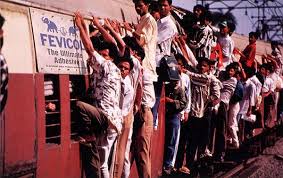
Conceptualized by Ogilvy & Mather, the campaign cleverly used animation and metaphor to reinforce its long-standing message: “Fevicol ka jod hai, tootega nahi.” But this time, it wasn’t just about physical bonding—it was about emotional solidarity, symbolic of India’s strength as a united nation.
Launched digitally and supported across social media, the video quickly gained traction and was widely appreciated for its thoughtful storytelling, patriotic sentiment, and brand relevance. It reminded audiences that just like it holds things together permanently, so does the spirit of Republic Day, which celebrates the Constitution and the values that bind the nation.
The “Train of Unity” stood out not only as a powerful Republic Day tribute, but also as a shining example of purpose-driven branding—where a commercial message becomes a heartfelt celebration of national identity and cohesion.
9. Fevicol Boatman Ad
The Fevicol Boatman Ad is a classic example of how the brand blends humor, exaggeration, and product benefit into an unforgettable storytelling experience. Launched as part of its legacy of clever advertising, the ad centers around a humble boatman whose tiny wooden boat is inexplicably overloaded with passengers—yet shows no sign of breaking or sinking.
The ad opens with a calm riverside scene where a boatman ferries people across the river. As each passenger steps into the already-crowded boat, the viewer expects it to capsize. But it doesn’t. The number of people continues to grow—men, women, animals, even furniture are crammed into the tiny vessel. Spectators onshore look on in disbelief as the boat continues to float, packed far beyond its capacity.

What’s holding it all together? Of course—Fevicol. A quick cut to the branding element reveals that the boat was constructed using Fevicol adhesive, implying that the “Fevicol ka jod” is so strong that even this absurd load cannot tear it apart.
The genius of the Fevicol Boatman Ad lies in its visual exaggeration paired with deadpan humor. There’s no loud background score or dramatic narration—just a simple yet effective portrayal of a product benefit taken to an illogical extreme, a signature style Fevicol has mastered over decades.
Not only does this ad entertain, but it also strongly reinforces the brand’s USP: unbreakable adhesion. It appeals to both rural and urban audiences, resonating with carpenters, contractors, and everyday consumers alike.
By using a familiar setting, relatable characters, and unexpected humor, the Fevicol Boatman Ad sticks in the minds of viewers—much like its product does in real life.
10. Fevicol’s “Tug of War” Print Ad
Fevicol’s “Tug of War” print ad is a masterclass in minimalist creativity and powerful brand messaging. Without using a single word, the ad manages to convey everything that Fevicol stands for—strength, reliability, and unbreakable bonds—all through a brilliantly executed visual metaphor.
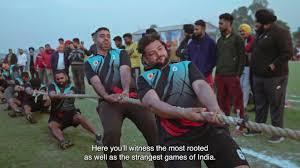
The ad features a classic game of tug of war, but with a twist. On either end of the rope, massive teams of people are seen pulling with all their might. However, in the center of the rope, there’s a small dab of Fevicol, which neither side can break through. The rope is stretched to its limit, tension is high, muscles are straining—but the Fevicol bond holds firm.
This clever, text-free visual does all the talking. It plays on the brand’s iconic tagline—“Fevicol ka jod hai, tootega nahi”—without having to spell it out. The exaggerated, yet believable scene makes the viewer instantly understand the strength of Fevicol’s adhesive power, and at the same time, leaves them with a smile.
What makes this ad particularly impactful is its universal appeal. Whether the viewer is from an urban or rural background, young or old, literate or not, the concept is immediately understandable. This reflects Fevicol’s long-standing ability to communicate with diverse audiences through smart, context-driven visuals.
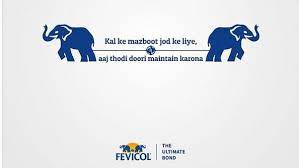
The “Tug of War” ad has been widely praised in creative circles for its art direction, conceptual clarity, and brand consistency. It’s a shining example of how less is more when the idea is strong, relevant, and well-executed.
By turning a simple game into a powerful brand metaphor, Fevicol once again proved why its advertising—like its glue—sticks in the minds of consumers.
Conclusion on Fevicol’s Marketing Campaigns
Fevicol’s marketing campaigns have become legendary in Indian advertising, blending wit, cultural relevance, and product-centric storytelling to build a brand that is not only memorable but also deeply trusted. From its early days to its latest digital and topical stunts, Fevicol has consistently communicated its core message — “Fevicol ka jod hai, tootega nahi” — across every medium with unmatched creativity and consistency.
What sets Fevicol apart is its deep understanding of the Indian audience, cutting across regions, languages, and social classes. Its campaigns use everyday scenarios, rural imagery, relatable humor, and clever exaggeration to highlight product benefits in a way that feels authentic and entertaining. Whether it’s the overloaded bus, the unbreakable egg tray, or the massive crowd on a tiny boat, every idea reinforces the brand’s promise of strength and durability.
Moreover, Fevicol has successfully evolved with the times. From iconic television commercials in the 90s to interactive billboards, Republic Day digital campaigns, and real-time social media topicals, the brand has shown remarkable agility in staying relevant without losing its essence. It’s moment marketing and topical posts prove that even a glue brand can dominate digital conversations when driven by smart, humorous, and timely content.
Fevicol’s campaigns are more than just advertisements—they are cultural markers that have shaped how Indian audiences think about advertising itself. The brand’s long-standing partnership with Ogilvy & Mather has led to some of the most award-winning and talked-about campaigns in the industry.
In conclusion, Fevicol’s marketing journey is a testament to the power of strong brand identity, creative storytelling, and emotional connection. Its campaigns do more than sell a product—they stick with people, just like the adhesive they celebrate.

